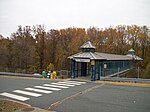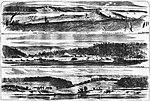Freestone Point Confederate Battery

Freestone Point Confederate Battery is a historic American Civil War gun emplacement located at Leesylvania State Park, Woodbridge, Prince William County, Virginia. The battery has four individual gun emplacements, which are fairly simple in configuration. All are formed by a large, deep, rectangular depression with high earthen berms built up on the north and south side of each depression. Three of the batteries are located on the cliff about 90 feet above the Potomac River. For five months, from October 1861 to March 1862, the batteries contributed to the Confederate military's success in blockading the Potomac River.It was listed on the National Register of Historic Places in 1989.
Excerpt from the Wikipedia article Freestone Point Confederate Battery (License: CC BY-SA 3.0, Authors, Images).Freestone Point Confederate Battery
Neabsco Beach Way,
Geographical coordinates (GPS) Address Nearby Places Show on map
Geographical coordinates (GPS)
| Latitude | Longitude |
|---|---|
| N 38.592777777778 ° | E -77.249166666667 ° |
Address
Leesylvania State Park
Neabsco Beach Way
22191
Virginia, United States
Open on Google Maps






